Martha Graham Dance Company at the Joyce Theater, February 14 through 26.
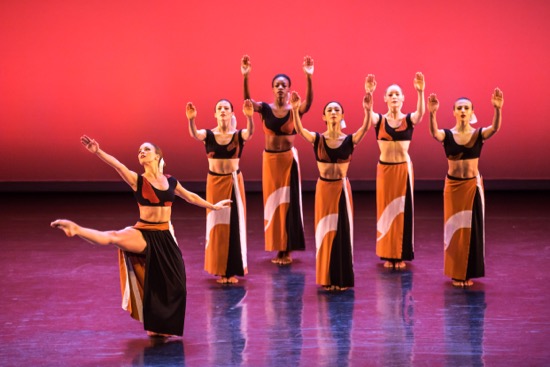
The women of Martha Graham’s Dark Meadow. (L to R): Anne O’Donnell, Laurel Dalley Smith, Leslie Andrea Williams, So Young An, Charlotte Landreau, and Marzia Memoli. Photo: Brigid Pierce
I’ve already written about the three new works that the Martha Graham Dance Company has acquired (https://www.artsjournal.com/dancebeat/2017/02/the-martha-graham-dance-companys-new-visions/). Of the remaining pieces programmed for the company’s season at the Joyce Theater, one is Nacho Duato’s 2013 Rust for five of the company’s exceptional men, and the remaining six are by Graham. Captured on film or video, remembered by those who danced in them when Graham was alive, they require only dedicated coaching and performing. The 1931 Primitive Mysteries was re-invented in 1964 by a cadre of its original performers foraging through their memories and Barbara Morgan’s photographs, and that revival was filmed. Diversion of Angels has been in and out of the repertory ever since it premiered in 1948 and was filmed in 1975. Maple Leaf Rag, Graham’s last dance, premiered in 1990, and the company may have footage of that as well as dancers’ recollections.
Because I love to see Graham’s greatest works in their entirety, I don’t always feel happy about creative choices that work against that, even though I’m grateful that many of artistic director Janet Eilber’s decisions have prolonged the life of the company Graham founded and brought new audiences to the choreography. During the Joyce season, only a portion of Graham’s evening-long 1958 Clytemnestra is programmed (as Clytemnestra Act 2). Dark Meadow, Graham’s great, mysterious Jungian adventure of 1946, appears as Dark Meadow Suite, minus its Noguchi décor of phallic pillars. And her 1933 solo Ekstasis has been “re-imagined” by Virginie Mécène, director of the Martha Graham School of Contemporary Dance and artistic director of Graham 2 (I have not seen Rust, Diversion of Angels or Clytemnestra Act 2 this season.)
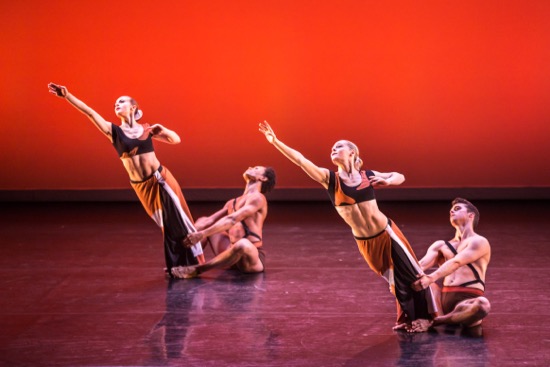
Dark Meadow Suite. (L to R): Marzia Memolia, Abdiel Jacobsen, Charlotte Landreau, and Lloyd Mayor. Photo: Brigid Pierce
For what could be considered a fertility ritual in terms of her artistic life, Graham created marvelous dances for a chorus of women and men. Slapping their hips, pounding their heels on the floor, springing into the air, they’re intense celebrants. The circles in which they sometimes congregate suggest a ritual ground, and there’s something totemic about their clarity. Several couples enact images that hint at something beyond mating. The men may lie briefly on top of their partners and carry them away hooked onto their backs, but they also sit and brace them as they lean out at a slant, like figureheads on a ship, both men and women swaying together.
Eilber is credited for the “arrangement” of Dark Meadow, and Carlos Chavez’s score was edited and re-arranged to fit it, since she incorporated passages of movement belonging to two of the principal characters. Lloyd Mayor’s big backward, almost staggering hops were once performed by Erick Hawkins as “He who summons,” and Anne Souder may have been given movements that were Graham’s as “One Who Seeks.” All twelve dancers enact the intensely beautiful group passages as if they believed in the power of every step.
The same is true of Primitive Mysteries, but here something different is required of its all-female cast. Often shoulder-to-shoulder in their groups, they must move as one (a member of the original cast remembered Graham at rehearsals laying a broom across their shoulders like a yoke). The twelve women in their simple, deep blue gowns, must also strike sudden moves simultaneously in order to frame or respond to the woman in white, who both leads them and is guarded and succored by them. In making Primitive Mysteries, Graham was inspired by the American Indian dances she had seen in the Southwest. This woman is a member of the community, chosen for the role of Mary as radiant mother and as mater dolorosa at the foot of the Cross. When Primitive Mysteries was first revived in 1964, Graham told the cast to remember that any one of them could have been selected for this role by her village. Peiju Chien-Pott performs it very beautifully, but, to me (someone who finds this dance among the 20th century’s greatest), she seems a little too concerned with Mary’s personal ecstasy, instead of experiencing the feelings at one remove from that holy figure.
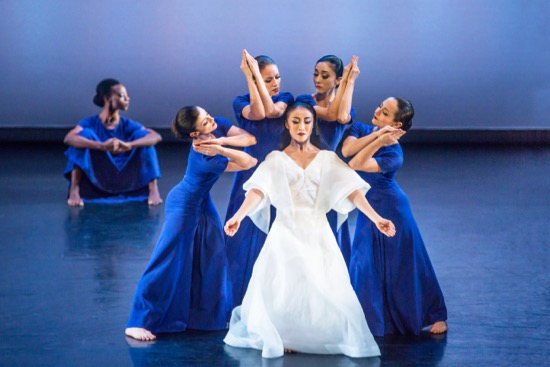
Martha Graham’s Primitive Mysteries. PeiJu Chien-Pott, surrounded by (L to R): Laurel Dalley Smith, Anne O’Donnell, So Young An, and Carley Marholin; Leslie Andrea Williams (seated rear). Photo: Brigid Pierce
The women perform with immense conviction, from the small, iconic gestures to the great gulps of leaps that they execute in a circle around the central figure in the final section. With their arms locked behind them, their bodies bent forward, they have the avidity of birds of prey, until the tempo of Louis Horst’s simple music for flute, oboe, and piano speeds up so much that they are running.
One thing disturbed me about Primitive Mysteries as it was performed at the gala on February 15th. In varying formations, the women process gravely onto the stage and off it for each of the work’s three sections (“Hymn to the Virgin,” “Crucifixus,” and “Hosanna”). This revival was coached, I believe, by Denise Vale, the company’s senior artistic associate and rehearsal director, but I don’t know for sure the source of the timing for their walks. In the 1964 performance, the way in which each woman stepped onto one reaching foot, then brought the other foot together with it before taking the next step was measured and deliberate, but you never lost the feeling that they were progressing together toward a destination. Members of this cast pause for approximately five seconds between steps. This, I suppose, enhances an image of them as iconic figures, but diminishes the importance of their journey to and from the dancing place.
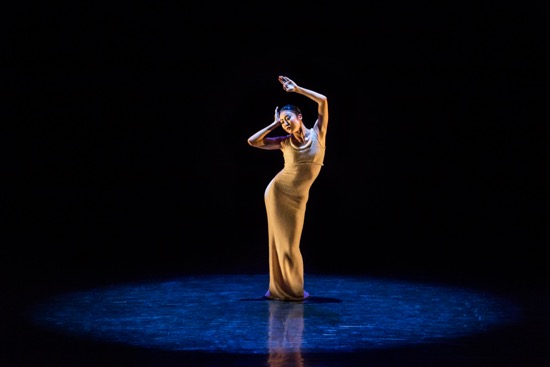
Peiji Chien-Pott in Martha Graham’s Ekstasis. Photo: Brigid Pierce
Ekstasis is not the first solo to be reimagined through photographs and written descriptions, and there’s no way to prove how faithful to the original Mécène’s version can be, even though she has done extensive research. It is not performed to Lehman Engel’s original score, but to the spare and mystical “Interludis meditatius – VII,” one of the interludes that punctuate the songs that comprise Ramón Humet’s Homenaje a Martha Graham (an inspired choice). What Mécène focused on is the counterbalance between the dancer’s jutting hip and the shoulders that pull the opposite way. Confined to a spotlight, Chien-Pott, slender and lithe, dreamily accentuates this S curve in sculptural ways. You can’t take your eyes off her. The costume helps focus our intention on her torso; she wears a form-fitting, ankle-length sheath that keeps her legs fairly close together (I wish the costume could be made of a fabric as textured as that of the knitted one that Graham wore).
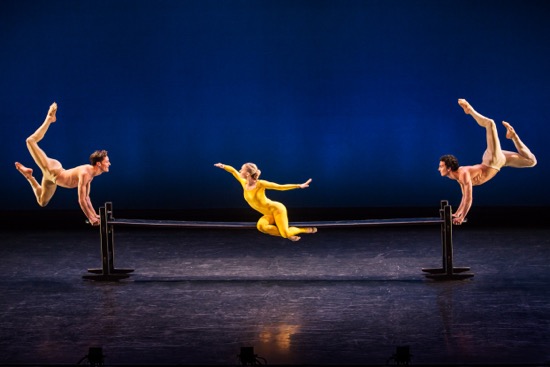
Martha Graham’s Maple Leaf Rag. (L to R): Jacob Larsen, Charlotte Landreau, and Lorenzo Pagano. Photo: Brigid Pierce
Program B closes with the company dancing to pre-existing music, a selection of piano rags written by Scott Joplin (“Elite Syncopations,” “Bethena,” and “Maple Leaf Rag”). Graham was 96 when she choreographed Maple Leaf Rag, and, as you might have expected, she recycled and transformed many images and movements from earlier dances. It’s a light-hearted, gently satirical piece whose ancestry can be traced back to her 1939 Every Soul is a Circus, 1941 Punch and the Judy, and 1960 Acrobats of God. The main difference is that she was not its heroine—in the earlier works a woman distractedly, but slyly weighing her options with an arrogant man (in two of these cracking a whip).
One of the structural forces controlling Maple Leaf Rag is its set—no Noguchi sculpture, but a “joggling board” like those that had fascinated Graham on a trip to Charleston, South Carolina. Not only does this bench stretch between legs on rockers, it’s made of springy, bendable wood. Depending on how many people sit on it, it can sag quite a lot. Sitting on one and joggling was once considered exercise for those avoiding a strenuous workout. Or perhaps doing so soothed the nerves like time spent in a rocking chair.
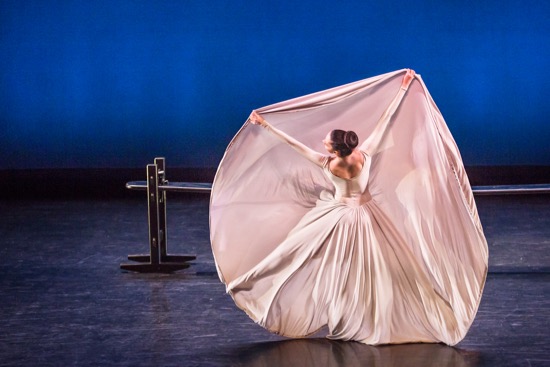
Konstantina Xintara in Martha Graham’s Maple Leaf Rag. Photo: Brigid Pierce
Graham’s choreography gives that structure itself a workout. Men face each other holding onto its opposite ends and kick their legs in the air. The playfully flirting principal couple (Charlotte Landreau and Mayor) sits on it and cuddles; he crawls naughtily beneath her skirt as she lounges there. A bit later, he whips that skirt off and carries it away like a trophy. At one point, three men stand on the apparatus, while their partners lie on the floor in front of them, legs in the air. The performers (eighteen in all) leap through, stop and rest a while, pair up. Intermittently, Konstantina Xintara, wearing a long dress with a circular skirt, wheels across the front of the stage, as if she has emigrated from another dance and wants nothing to do with these athletic youngsters. The dancers have a thoroughly good time with Maple Leaf Rag and show off not only their impressive skills but their (fortunately) good balance on that unstable board. I was especially impressed by Landreau; her clarity, her timing, and her focus drew my eye in every work she graced.
Anyone who could mastermind a light-hearted, impudent piece like this in her 97th year on earth was surely a match for death, hoping her final bow to that spectral visitor waiting in the wings would be a gracious one.

Gorgeous, graceful, heartfelt writing, knowledgeable too–you set the bar high, very, for the rest of us. And I’m grateful for it.
you are so correct in commenting about the chopping up of some of grahams ballet and presenting a readers digest form of them. as an audience i want to see the works as much as possible as she choreographed them. otherwise as always i appreciated your skilled eye and knowledge to give those of us who live far away an idea of the performance you saw.